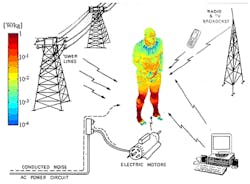How Does EMI Affect the Human Body and Brain?
This article is part of the TechXchange: Delving into EMI, EMC and Noise
Members can download this article in PDF format.
What you'll learn:
- How EMI affects deep-brain-stimulation devices.
- EMI's impact on human body communication.
- Increased risk of childhood leukemia due to extremely low electromagnetic fields.
During the last 50 years, man-made electromagnetic energy, leaking into our environment, has grown exponentially. This energy is not intentional but does cause interference with our environment as well as our human bodies.
In today’s world, everyone has a cell phone, and we’re also surrounded by high-voltage power lines. How does EMI affect our nervous systems (see figure)?
A very key parameter for effects on the human body is the frequency of EMI. Cell-phone radiation occurs at higher frequencies than powerline radiation—over a million times higher. High frequencies tend to penetrate less while heating human tissue, similar to a microwave oven. It’s been speculated that high-frequency electromagnetic energies may interfere and resonate with DNA and other cellular functions that may trigger cancerous changes.
The Brain
Deep brain stimulation (DBS) has become an approved and successful treatment for movement, obsessive-compulsive, and epilepsy disorders that are resistant to standard medical therapy. However, unintentional and intentional sources of external electromagnetic interference (EMI) may lead to either malfunctioning or damaged DBS devices, along with possible injury to human tissue.
Various generations of implantable pulse generators (IPGs) exist in DBS devices. In a normally operating DBS device, there will be a generated pulse from the IPG that travels through an extension cable to the patient neural contacts to stimulate a particular target. These are very complex medical devices that can send out unintentional, or even intentional, EMI.
The DBS system may be susceptible to unwanted currents, via either inductive, conductive, or radiated energy transfer, which can lead to neurological risks to the patient or even device malfunction such as switching the system on or off. This kind of disruption may harm the patient. Especially in the developing field of treatment for psychiatric disorders, the possibility of devastating consequences can happen if therapeutic efficacy becomes compromised or lost due to EMI.
The U.S. government also has tested high-power microwave weapons with the ability to disrupt animal and human behavior. This was attributed to heating of the brain by microwaves.
How EMI Affects Human Body Communication
In human body communication (HBC), the body becomes a medium for transmitting data between devices (smartphones, smartwatches, smart glasses, etc.) as a replacement for wired as well as wireless technologies. The human body will function as an antenna in the low-frequency band used by HBC. Due to this antenna function, electromagnetic waves, radiating from electronic devices or wireless services, cause EMI in HBC devices.
Cancer Risk from EMI Radiation
In 2015, the European Commission Scientific Committee on Emerging and Newly Identified Health Risks reviewed electromagnetic fields, and in particular, cell phones. Their findings were that epidemiologic studies of extremely low fields showed an increased risk in childhood leukemia from daily dosages over 0.3 to 0.4 µT.
This committee also found that the epidemiologic studies on radio-frequency (RF) exposure did not show an increased risk in brain tumors or other cancers of the head and neck region, although the possibility of an association with acoustic neuroma remains open for further study.
Summary
This article has covered the potential harmful effects of EMI on humans. All people, and especially those with pacemakers and ICDs, should not take these warnings lightly. Exposure to wavelengths and frequencies mentioned in this article can lead to the possible cause of several health conditions. People exposed to high-frequency technology should consider what they can do to protect themselves from exposure. This article also outlines ways in which people can avoid such EMI effects.
Read more articles in the TechXchange: Delving into EMI, EMC and Noise
References
- "Deep brain stimulation and electromagnetic interference," US National Library of Medicine, National Institutes of Health
- "Electromagnetic Interferences (EMI) and their effect on the nervous system," Dr. Nagi Hatoum, M.D., MSEE.
- "Effect of Electromagnetic Interference on Human Body Communication," IEEE Transactions on Electromagnetic Compatibility, Vol. 59, No. 1, February 2017

